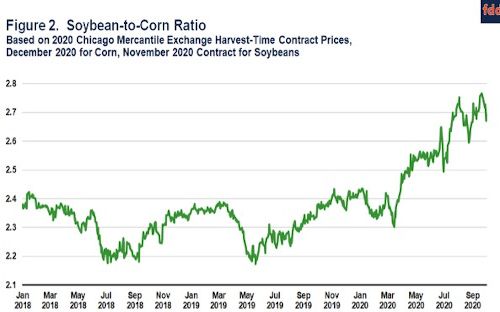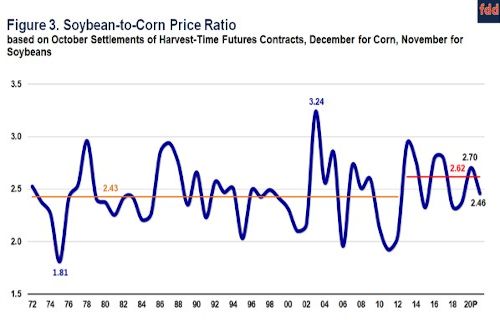Coronavirus control measures had a more substantial impact on corn than soybeans , resulting in corn prices decreasing more than soybean prices, as is illustrated by the soybean-to-corn price ratios shown in Figure 2. The soybean-to-corn price ratio equals the soybean price divided by corn price. Increasing soybean-to-corn price ratios indicate that soybean prices have increased relative to corn prices. As shown in Figure 2, the soybean-to-corn price ratio increased from February to August and has been relatively stable since August. In February, the soybean-to-corn price ratio was 2.34 ($9.17 soybean price / $3.88 corn price). From September 28 to October 3, the soybean-to-corn price ratio averaged 2.70 ($10.15 soybean price / $3.76 corn price).

A 2.70 soybean-to-corn price ratio is above 2.62, the average 2013-2019 soybean-to-corn price ratio based on settlement prices of the CME futures contracts during October (see Figure 3). While the current ratio is above the 2013-2019 average, there were several recent years in which the soybean-to-corn price ratio was even higher than the current 2.70 ratio: 2.93 in 2013, 2.77 in 2013, 2.80 in 2016, and 2.79 in 2017.

The average 2.62 price ratio during the 2013-2019 period is higher than the 2.43 average from 1972 to 2012. Corn use in producing ethanol increased from 2006 to 2013, with corn use in ethanol being stable since 2013 (see farmdoc daily, September 22, 2020). Since the growth in ethanol production reached a plateau, soybean prices have generally been higher relative to corn as compared to the 1972-2012 period.
Profitability Implications
Figure 4 shows corn-minus-soybean returns for farms enrolled in Illinois Farm Business Farm Management (FBFM) on high-productivity farmland in central Illinois. Before 2013, corn was more profitable than soybeans in most years. From 2013 onwards, soybeans have been more profitable than corn. Several factors contribute to this change in 2013, including exceptionally good soybean yields in many years. Soybean prices relative to corn prices have also played an important role in this shift in profitability.

For 2020, soybeans again are projected to be more profitable than corn. On high-productivity farmland in central Illinois, operator and land returns are projected at $314 per acre for corn and $348 for soybeans , giving soybeans a $34 per acre advantage over corn. These 2020 projected returns include good yields for corn (230 bushels per acre) and soybeans (72 bushels per acre), and the second round of Coronavirus Food Assistance Program (CFAP) payments.
Our current projections suggest that soybean returns will exceed corn returns again in 2021 (see 2021 Crop Budgets), as has been the case since 2013. Recent events likely reinforce this situation where soybeans are more profitable than corn. COVID-19 control measures have reduced travel, leading to reductions in fuel and ethanol use, which depresses corn demand. Alternatively, soybean prices are supported by recent exports of soybeans to China that are strengthening demand for soybeans.
Source : illinois.edu